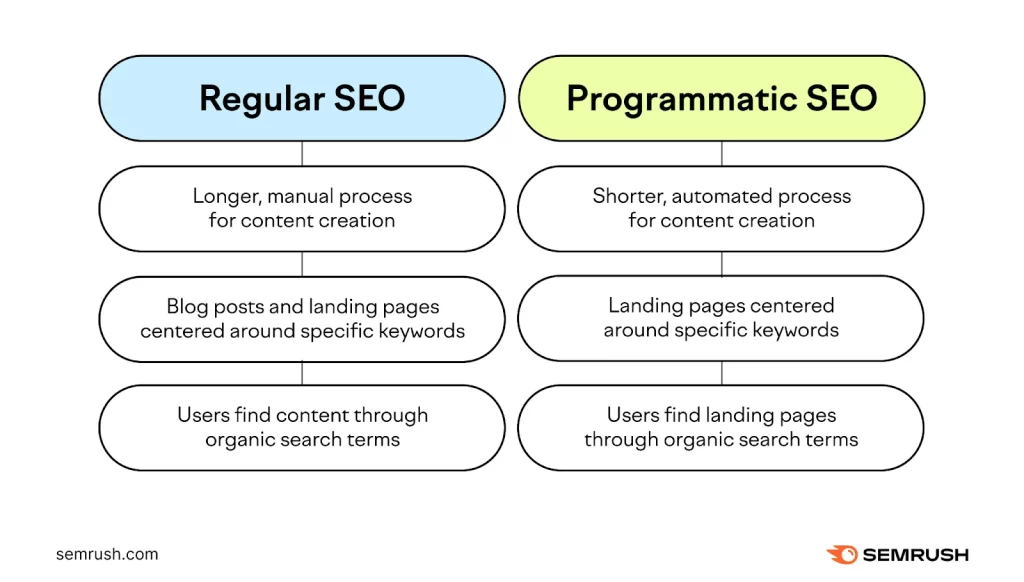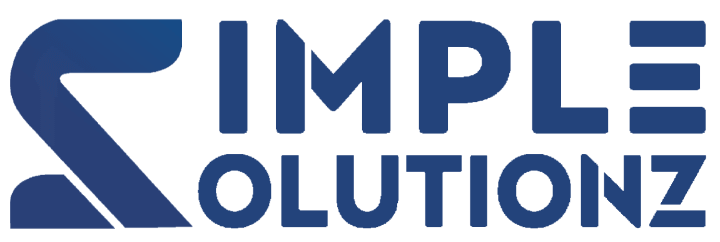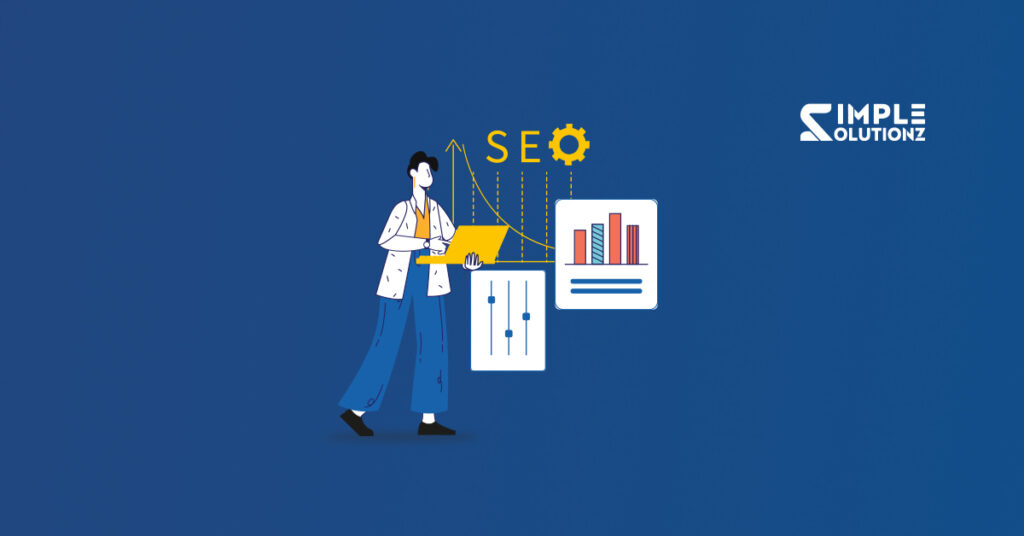SEO strategies prove the success and failure of any business. But how can you optimize your website with a better approach? Well, the top secret is programmatic SEO. Why is programmatic SEO the future of Search Engine Optimization?
This innovative approach transforms how businesses approach local and global SEO campaigns, offering unparalleled precision, efficiency, and scalability.
Let’s read more about the key aspects of Programmatic SEO and explore how it is reshaping the future of online visibility.
Contents
How Do You Know About Programmatic SEO?
Programmatic SEO is a technique that leverages automation and machine learning to dynamically optimize a website’s search engine performance. Unlike traditional SEO methods that rely heavily on manual intervention and fixed strategies, Programmatic SEO adapts in real-time to changes in search engine algorithms, user behavior, and market trends.
How Does Programmatic SEO Work?
Programmatic SEO uses automation, machine learning, and real-time data analysis to optimize a website’s search engine performance dynamically. Unlike traditional SEO methods, master strategies for brand growth often involve manual interventions and fixed strategies. Programmatic SEO adapts and evolves based on changing factors such as search engine algorithms, user behavior, and market trends.
Here is a breakdown of how programmatic SEO works:
Real-Time Data Analysis
Programmatic SEO relies on real-time data analysis to understand and respond to changes in the search landscape. This includes monitoring user behavior, keyword trends, and other relevant metrics that impact a website’s performance on search engines.
Dynamic Keyword Targeting
Instead of relying on static keyword lists, programmatic SEO dynamically adjusts keyword targeting based on real-time data. This ensures that the website is optimized for the most relevant and high-performing keywords at any given moment.
Content Personalization
Programmatic SEO analyzes user behavior, preferences, and demographics to personalize content dynamically. This means that visitors see content tailored to their needs, improving engagement and increasing the likelihood of conversion.
Automated Link Building
Building high-quality backlinks is a crucial aspect of SEO. Programmatic SEO automates link-building by identifying and securing relevant and authoritative links in real-time. This helps improve a website’s domain authority and search engine rankings.
Adaptive Website Optimization
Programmatic SEO continuously analyzes user interaction data to optimize various website elements. This includes improving page speed, ensuring mobile responsiveness, and enhancing overall user experience. The adaptive nature of programmatic SEO keeps the website aligned with current search engine ranking factors.
Multichannel Integration
Programmatic SEO often integrates with other digital marketing channels, such as social media and paid advertising, to ensure a cohesive and comprehensive online presence. This integration allows for a unified approach to digital marketing efforts, optimizing strategies across multiple channels.
Machine Learning Algorithms
At the heart of programmatic SEO are machine learning algorithms. These algorithms scrutinize extensive datasets to recognize patterns, trends, and correlations. As they gain insights from the data, they enhance their ability to make precise predictions and adapt the SEO strategy over time.
Global and Local Optimization
Programmatic SEO can optimize both globally and locally. It can adapt strategies for businesses with a global footprint, considering language, cultural nuances, and regional search engine preferences. Simultaneously, it excels in local optimization by precisely targeting specific geographical areas.
Continuous Monitoring and Adjustment
Programmatic SEO is a continuous process that involves constant monitoring and adjustment. As the digital landscape evolves, including changes in search engine algorithms, programmatic SEO ensures that the optimization strategy remains effective and current.
Search Engine Optimization (SEO) has evolved significantly over the years, and one of the latest trends making waves in digital marketing is Programmatic SEO.

Benefits of Programmatic SEO
Real-time Adaptability: Programmatic SEO excels in adapting to real-time changes. Search engine algorithms are dynamic, and user behavior evolves. Programmatic SEO ensures that your website’s optimization strategy always aligns with the latest trends, giving you a competitive edge.
Precision Targeting: This approach enables precise targeting of keywords based on real-time data analysis. By dynamically adjusting keyword targeting, Programmatic SEO ensures that your content remains relevant to the changing search landscape, leading to improved rankings and visibility.
Enhanced User Experience: Programmatic SEO goes beyond traditional SEO by continuously analyzing user interaction data. This enables the optimization of website elements such as page speed, mobile responsiveness, and overall user experience, contributing to higher engagement and conversion rates.
Efficient Link Building: Building high-quality backlinks is automated through Programmatic SEO. The system identifies and secures relevant, authoritative links in real time, contributing to improved domain authority and search engine rankings.
Personalized Content: Content personalization is a key strength of Programmatic SEO. Analyzing user behavior, preferences, and demographics ensures that visitors receive tailored content, leading to higher engagement and conversion rates.
Local SEO Revolution
Benefits of local SEO for a small business: programmatic SEO brings about a revolution in local SEO strategies:
Geo-Targeted Keyword Optimization: Programmatic SEO identifies location-specific keywords, allowing businesses to target their audience precisely. This is essential for local businesses seeking to attract the interest of prospective customers within geographic regions.
Real-Time Local Search Trends: Local search trends can change rapidly, and Programmatic SEO keeps businesses ahead of the curve by analyzing real-time data. This ensures that local SEO strategies remain relevant and effective in the face of evolving consumer behavior.
Localized Content Strategies: Programmatic SEO enables businesses to craft content that resonates with local audiences. Whether it is incorporating regional language nuances or addressing location-specific concerns, this approach ensures that content is tailored to the local context.
Global SEO Optimization
For businesses with a global footprint, Programmatic SEO offers the scalability required to navigate diverse markets while maintaining local relevance:
Multilingual SEO Optimization: Global businesses must often cater to audiences speaking different languages. Programmatic SEO streamlines the process of multilingual SEO optimization, ensuring that each regional version of a website is optimized for local search engines.
Cultural Sensitivity in Content Creation: Programmatic SEO considers cultural nuances and preferences, allowing businesses to create content that resonates with diverse global audiences. This cultural sensitivity is crucial for building trust and credibility in international markets.
Adaptive Global SEO Strategies: The global market is dynamic, with varying competition levels and user behaviors. Programmatic SEO adapts global SEO strategies based on real-time data, ensuring businesses can stay competitive and agile in the ever-changing global landscape.
Practical Tips for Implementing Programmatic SEO
Invest in the Right Technology
To implement Programmatic SEO successfully, invest in the right technology and tools. This includes advanced analytics platforms, machine learning algorithms, and automation tools. Choose solutions that align with your business goals and scale as your needs grow.
Define Clear Objectives
Clearly define your SEO objectives and key performance indicators (KPIs). Whether focused on local visibility or global expansion, having well-defined goals will guide your Programmatic SEO strategy and help measure its success.
Embrace Data-driven Decision Making
Programmatic SEO relies heavily on data. Make data-driven decisions by regularly analyzing performance metrics, user behavior, and market trends. Use this data to refine your SEO strategy and stay ahead of the competition.
Prioritize User Experience
A favorable user experience is vital for achieving SEO success. Identify that your website is optimized for mobile devices, boasts swift loading times, and delivers a smooth navigation experience. Programmatic SEO’s adaptive website optimization capabilities can assist in maintaining an excellent user experience.
Create Quality, Relevant Content
Content remains a critical factor in SEO. Leverage the personalization capabilities of Programmatic SEO to create high-quality, relevant content. Craft content that addresses your target audience’s needs and incorporates the keywords identified through real-time analysis.
Stay Informed and Adapt
Programmatic SEO is in a constant state of evolution. Stay abreast of industry trends, updates in algorithms, and progress in machine learning. Cultivate a culture of ongoing learning within your team to adjust to shifts and optimize the capabilities of Programmatic SEO to the fullest.
While Programmatic SEO offers numerous advantages, it is essential to acknowledge its drawbacks and challenges. Understanding these limitations helps businesses make informed decisions about adopting this approach.
Here are Some Drawbacks of Programmatic SEO
Initial Implementation Costs
Implementing Programmatic SEO requires a significant upfront investment in technology, tools, and skilled personnel. Small businesses or those with budget constraints may struggle to justify these initial costs.
Dependency on Technology
Programmatic SEO heavily relies on advanced technology, machine learning algorithms, and automation tools. A dependence on technology means that any disruptions, technical glitches, or malfunctions can impact the effectiveness of the SEO strategy.
Data Privacy Concerns
The use of real-time data in Programmatic SEO raises concerns about data privacy and compliance with regulations such as GDPR (General Data Protection Regulation). Businesses must implement robust measures to ensure ethical data practices and compliance with relevant laws.
Complexity and Learning Curve
Programmatic SEO involves complex algorithms and data analysis techniques. Businesses may face a steep learning curve when implementing and managing programmatic strategies, requiring tea training, or hiring specialized personnel.
Potential for Over-Optimization
The dynamic nature of Programmatic SEO can lead to over-optimization if not managed carefully. Constant adjustments based on real-time data may result in rapid and sometimes unnecessary changes, potentially affecting the stability and consistency of the SEO strategy.
Risk of Algorithmic Changes
While Programmatic SEO adapts to algorithmic changes, sudden and significant updates by search engines can still pose challenges. Algorithmic changes can impact the effectiveness of the automated strategies, and businesses may need to adjust their approach to promptly align with the new algorithms.
Difficulty in Attribution and Analysis
The complexity of Programmatic SEO can make it challenging to attribute specific outcomes directly to the programmatic efforts. Understanding the impact of individual optimizations or adjustments may require sophisticated analytics tools and careful analysis.
Not One-Size-Fits-All
Programmatic SEO may only be suitable for some businesses or industries. Some businesses may have unique characteristics or requirements that are addressed through traditional SEO methods or other digital marketing strategies.
Limited Human Touch
While automation is a strength, it can also be a limitation. Programmatic SEO may need a more human touch for creative content creation and strategy development. Human intuition and creativity are crucial in areas where automation may fall short.
Potential for Unintended Consequences
The rapid adjustments made by Programmatic SEO based on real-time data may lead to unintended consequences. Changes in one aspect of the strategy can impact other elements, and businesses must carefully monitor and assess the overall impact of these adjustments.
The Drawbacks of Programmatic SEO
Despite these drawbacks, many businesses find the benefits of Programmatic SEO outweigh the challenges, especially considering the speed, adaptability, and efficiency it brings to SEO campaigns. However, a thoughtful and strategic approach is essential to successfully navigate and mitigate these potential drawbacks.
Programmatic SEO is a meaningful change in digital marketing, offering businesses unprecedented control, precision, and adaptability in their SEO efforts. The benefits of real-time adaptability, precision targeting, enhanced user experience, efficient link building, and personalized content make it a powerful tool for local and global SEO campaigns.
Implementing Programmatic SEO requires strategic planning, investment in technology, and a commitment to data-driven decision-making. By following practical tips such as investing in the right technology, defining clear objectives, embracing data-driven decision-making, prioritizing user experience, creating quality content, and staying informed, businesses can harness the full potential of Programmatic SEO and position themselves for sustained online success in an ever-evolving digital landscape.

